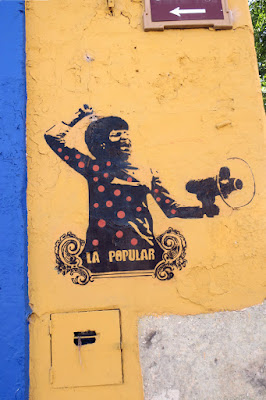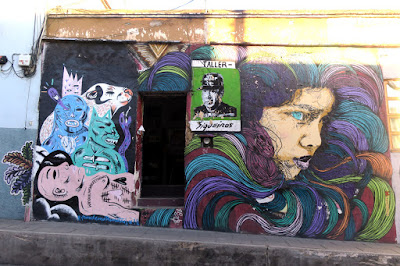(for best viewing of photos, click to enlarge and begin a slideshow)
I'm in Mexico, so let's talk about NAFTA. Or the wall!
Just kidding ... we're all inundated with politics so think of this as a short break from the horrors of our government's nefarious shenanigans (by looking at another government's shenanigans).
Aside from sun and warm weather, one bright light here is the colorful graffiti on the streets (and many of you know what a fan I am). It's all over the place!
It seems different from graffiti in Egypt (multi-layered, angry, humorous, illegal,
ever-changing—see my blog post on graffiti in Cairo),
Miami (polished, appropriated by tourists), Brazil (didn't fully explore), New York
(the birthplace of graffiti, now currently sponsored by high-end clothing stores). There's both a political and technical sophistication, and a tendency towards cartoons. Graffiti is illegal in Oaxaca as well, sometimes garnering a $40,000 peso fine.
Artists from every country include symbols and motifs inherent in their culture and history, but there are similarities all over the world. And like any art, there are various motives to create graffiti, along with styles (narrative, abstract, political, allegorical, tagging), methods and techniques (wood cuts, stencils, paint, stickers).
While public art and work of the storied Mexican muralists have been significant here (and around the world) for decades, 2006 marked a resurgence of art in the streets. In June of that year, a theretofore annual teacher's strike ended violently and spurred masses of people to demand resignation of the Oaxacan state governor (e.g. Cuomo) and to express their strong opposition to the chronic problems of poor education, poverty, indigenous rights, environmental degradation, among others (sound familiar?).
The people came together to form The Popular Assembly of the Peoples of Oaxaca (APPO, from its Spanish name, Asamblea Popular de los Pueblos de Oaxaca), including "representatives of Oaxaca's state regions and municipalities, unions, non-governmental organizations, social organizations, cooperatives, and parents." (*)
The protests lasted for months, with encampments (not unlike Occupy Wall Street, although this happened a few years earlier) proliferating in the famed Zócalo of downtown Oaxaca. Eventually, the people staged massive takeovers of radio and television stations, a college campus, and other actions.
Ultimately, in November, the Mexican government violently shut the protests down -- some people were killed with many disappeared. During this historic time in 2006, however, people embraced a resurgence of street art as a means of occupation and communication. Art collectives flourished and many still operate in Oaxaca today.
I hope to write a blog post about the numerous printmaking collectives (silkscreen, intaglio, etching, etc.) around town. Meanwhile, below are some interesting links if you want to follow up. There is history, and lots more pics of graffiti that I have yet to encounter. Please feel free to join this blog and share it.
 |
| "Imagine the universe dreaming in space, caressing the infinite, you're balanced on a comet, there's a star next to the moon, giving it precious cosmic love." |
- ·
“2006 Oaxaca
Protests,” Wikipedia, n.d. <https://en.wikipedia.org/wiki/2006_Oaxaca_protests>.
- ·
“About Occupy
Wall Street.” OccupyWallSt.org. N.p., n.d.
<http://occupywallst.org/about/>.
- ·
Arenas, Ivan. “Rearticulating the Social:
Spatial Practices,Collective Subjects, and Oaxaca’s Art of Protest,” University
of California, Berkeley, 2011. <http://escholarship.org/uc/item/8hm9v2hm#page-1>.
- ·
ASARO-Asamblea
De ArtistasRevolucionarios De Oaxaca | Jordan Schnitzer Museum of Art. N.p.,
11 Feb. 2014.<http://jsma.uoregon.edu/ASARO>.
- ·
Delana.
“Graffiti Designs & Styles: Tagging,
Bombing and Painting,” Web Urbanist: Architecture, Art, Design & Built
Enviroments. N.p.,
n.d. <http://weburbanist.com/2009/09/24/graffiti-designs-styles-tagging-bombing-painting/>.
- ·
Fuller, Becki. “Power To The People: The
StreetArt of Lapiztola.” The Street Spot. N.p., 10 Nov. 2010. <http://thestreetspot.com/tag/oaxaca>.
- ·
Global Research. “The Popular
Uprising in Oaxaca, Mexico.” Socialist Project e-bulletin No.
33 5 November 2006.
<http://www.globalresearch.ca/the-popular-uprising-in-oaxaca-mexico/3712>.
- ·
Jones, Sam. “Mexico's
Street Art Tells Stories ofGrief, Anger and Resistance.” The
Guardian. Guardian News and Media, 05 Feb. 2015.
<https://www.theguardian.com/global-development/2015/feb/05/mexico-oaxaca-murals-lapiztola-street-art-murals>.
- ·
Kordic, Angie. “All You Need
to Know About Mexican Muralism and Muralists.” WideWalls. N.p.,
n.d. Web. 10 Feb. 2017.
<http://www.widewalls.ch/mexican-muralism-muralists/>.
- ·
“La Señora.
La Niña. El Puerquito.” Lapiztola. N.p., 28 June 2015.
<http://lapiztola.blogspot.mx/2015/07/la-senora-la-nina-el-puerquito.html>.
- ·
“Oaxaca
Street Art: A Revolutionary Expression.” G Adventures Blog.
N.p., n.d.
<https://www.gadventures.com/blog/oaxaca-street-art-a-revolutionary-expression/>.
- ·
Poppytalk. “Photos by Jakedobkin, via
Flickr.” Pinterest. N.p., 02 Nov. 2012.
<https://www.pinterest.com/pin/26036504067215909/>.
- ·
Seeland, Ehren. ”Oaxaca at Street Level.” Fundación
En Via Blog. N.p., 09 May 2015.<https://fundacionenvia.wordpress.com/2015/05/07/oaxaca-at-street-level/>.
- ·
Taboada, Marcela. “Street Art
in Oaxaca, Mexico.” Project Bly, n.d.
<http://www.projectbly.com/destinations/oaxaca/art>.
- ·
“The Art of
Dissent: Woodcuts from the ASARO Collective ofOaxaca, Mexico.” DownStreet
Art, North Adams, MA. mcla.digication.com, 25 August 2011.
<https://mcla.digication.com/annscott/The_ASARO_COLLECTIVE>.
- ·
“Trayectivo:
Bringing Art to the People inOaxaca.” Mexico Retold. N.p., 03
Nov. 2016. <https://mexicoretold.com/2016/11/03/trayectivo-bringing-art-to-the-people-in-oaxaca/>.
- ·
“Urban/Street
Art.” NEH Summer Institute for School Teachers Oaxaca 2015.
Univ. of Oregon, 2015.
<http://blogs.uoregon.edu/mesoinstitute/about/curriculum-unit-development/arts-crafts/urbanstreet-art/>.
- ·
Vargas, Andrew S. “LAPIZTOLA OAXACA.” ART
REPRESENT. N.p., 8 June 2016. <http://www.artrepresent.com/lapiztola/>.
- · “2006 Oaxaca Protests,” Wikipedia, n.d. <https://en.wikipedia.org/wiki/2006_Oaxaca_protests>.
- · “About Occupy Wall Street.” OccupyWallSt.org. N.p., n.d. <http://occupywallst.org/about/>.
- · Arenas, Ivan. “Rearticulating the Social: Spatial Practices,Collective Subjects, and Oaxaca’s Art of Protest,” University of California, Berkeley, 2011. <http://escholarship.org/uc/item/8hm9v2hm#page-1>.
- · ASARO-Asamblea De ArtistasRevolucionarios De Oaxaca | Jordan Schnitzer Museum of Art. N.p., 11 Feb. 2014.<http://jsma.uoregon.edu/ASARO>.
- · Delana. “Graffiti Designs & Styles: Tagging, Bombing and Painting,” Web Urbanist: Architecture, Art, Design & Built Enviroments. N.p., n.d. <http://weburbanist.com/2009/09/24/graffiti-designs-styles-tagging-bombing-painting/>.
- · Fuller, Becki. “Power To The People: The StreetArt of Lapiztola.” The Street Spot. N.p., 10 Nov. 2010. <http://thestreetspot.com/tag/oaxaca>.
- · Global Research. “The Popular Uprising in Oaxaca, Mexico.” Socialist Project e-bulletin No. 33 5 November 2006. <http://www.globalresearch.ca/the-popular-uprising-in-oaxaca-mexico/3712>.
- · Jones, Sam. “Mexico's Street Art Tells Stories ofGrief, Anger and Resistance.” The Guardian. Guardian News and Media, 05 Feb. 2015. <https://www.theguardian.com/global-development/2015/feb/05/mexico-oaxaca-murals-lapiztola-street-art-murals>.
- · Kordic, Angie. “All You Need to Know About Mexican Muralism and Muralists.” WideWalls. N.p., n.d. Web. 10 Feb. 2017. <http://www.widewalls.ch/mexican-muralism-muralists/>.
- · “La Señora. La Niña. El Puerquito.” Lapiztola. N.p., 28 June 2015. <http://lapiztola.blogspot.mx/2015/07/la-senora-la-nina-el-puerquito.html>.
- · “Oaxaca Street Art: A Revolutionary Expression.” G Adventures Blog. N.p., n.d. <https://www.gadventures.com/blog/oaxaca-street-art-a-revolutionary-expression/>.
- · Poppytalk. “Photos by Jakedobkin, via Flickr.” Pinterest. N.p., 02 Nov. 2012. <https://www.pinterest.com/pin/26036504067215909/>.
- · Seeland, Ehren. ”Oaxaca at Street Level.” Fundación En Via Blog. N.p., 09 May 2015.<https://fundacionenvia.wordpress.com/2015/05/07/oaxaca-at-street-level/>.
- · Taboada, Marcela. “Street Art in Oaxaca, Mexico.” Project Bly, n.d. <http://www.projectbly.com/destinations/oaxaca/art>.
- · “The Art of Dissent: Woodcuts from the ASARO Collective ofOaxaca, Mexico.” DownStreet Art, North Adams, MA. mcla.digication.com, 25 August 2011. <https://mcla.digication.com/annscott/The_ASARO_COLLECTIVE>.
- · “Trayectivo: Bringing Art to the People inOaxaca.” Mexico Retold. N.p., 03 Nov. 2016. <https://mexicoretold.com/2016/11/03/trayectivo-bringing-art-to-the-people-in-oaxaca/>.
- · “Urban/Street Art.” NEH Summer Institute for School Teachers Oaxaca 2015. Univ. of Oregon, 2015. <http://blogs.uoregon.edu/mesoinstitute/about/curriculum-unit-development/arts-crafts/urbanstreet-art/>.
- · Vargas, Andrew S. “LAPIZTOLA OAXACA.” ART REPRESENT. N.p., 8 June 2016. <http://www.artrepresent.com/lapiztola/>.








































































Beautiful shots, Julie, thanks! Beautiful Mexico, as ever--and ever resistant!
ReplyDelete(from Jason Weiss)
Thanks, Jason. Nice to hear from you!
DeleteThis is wonderful reporting and documentation, Julie! Keep up the great work!
ReplyDeleteGlad you like it, Rob! Thanks for looking and reading!
DeleteWow, these are amazing! When I was in Sao Paolo there was gorgeous street art that gave the city a real vitality and character. Wonderful to read and view your blog, thank you for sharing these extraordinary works. Miss you!
ReplyDeleteSo glad you enjoyed it, Margaret! Let's talk soon.
DeleteLove all the shots of graffiti ! So beautiful and free !
ReplyDeleteLove Lauren
Love you, Lauren! Thanks.
DeleteYou have been busy and productive. Love all the images and the sentiment behind them.
ReplyDeleteThank you dear sister! Gracias...
DeleteWonderful photos ... & I live here! Impressive documentation too -- so helpful for putting it all into context. Gracias.
ReplyDeleteThank you so much, Laurie. You're the one who got me here! Mucho gracias a tú.
Delete